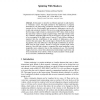HVEI
2009
14 years 2 months ago
2009
Human perception of material colors depends heavily on the nature of the light sources that are used for illumination. One and the same object can cause highly different color impr...
EGH
2010
Springer
14 years 2 months ago
2010
Springer
This paper presents a more efficient way of computing single scattering effects in homogeneous participating media for real-time purposes than the currently popular ray-marching b...
IJVR
2006
14 years 4 months ago
2006
This work presents an approach to render appropriate shadows with Image Based Lighting in Augmented Reality applications. To approximate the result of environment lighting and shad...
IVC
2008
14 years 4 months ago
2008
Most illuminant estimation algorithms work with the assumption of one specific type of the light source (e.g. point light source or directional light source). This assumption brin...
CGF
2007
14 years 4 months ago
2007
Recently, several real-time soft shadow algorithms have been introduced which all compute a single shadow map and use its texels to obtain a discrete scene representation. The res...
CGF
2006
14 years 4 months ago
2006
Generating soft shadows in real time is difficult. Exact methods (such as ray tracing, and multiple light source simulation) are too slow, while approximate methods often overesti...
VG
2001
14 years 6 months ago
2001
In this paper we describe an efficient approach to add shadows to volumetric scenes. The light emitted by the lightsource is properly attenuated by the intervening volumetric struc...
COMPGEOM
2007
ACM
14 years 6 months ago
2007
ACM
Computing shadow boundaries is a difficult problem in the case of non-point light sources. A point is in the umbra if it does not see any part of any light source; it is in full l...
SIGGRAPH
1991
ACM
14 years 8 months ago
1991
ACM
A major problem challenging opera designers is the inability to coordinate lighting, projection systems, and set designs in the preliminary planning phase. New computer graphics t...
RT
2000
Springer
14 years 8 months ago
2000
Springer
Soft shadows and penumbra regions generated by extended light sources such as linear and area lights are visual effects that significantly contribute to the realism of a scene. In ...


